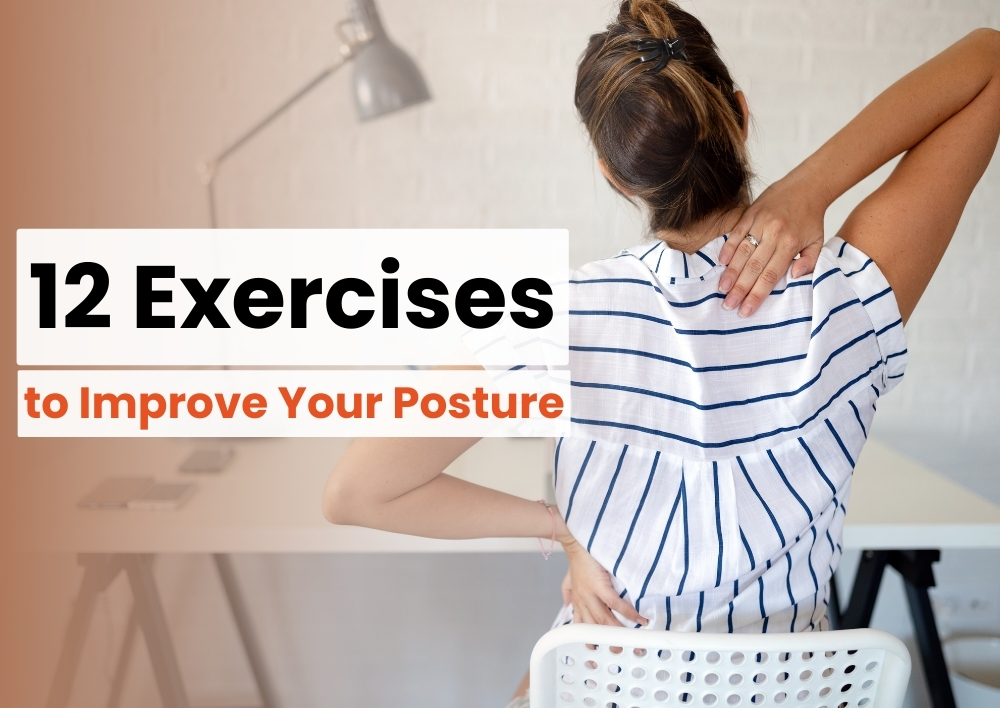12 Exercises to Improve Your Posture
Have you ever noticed yourself slouching in the mirror? Poor posture isn’t just about how you look, it affects how you feel, too. Slouching can cause pain and long-term health issues. But the good news is that you can fix it with some easy exercises. These exercises to improve posture will help you stand tall, feel great, and take care of your spine. Ready to straighten up? We’ve teamed up with the top physiotherapist in Gurgaon, Dr. Surender Mor at Miracles Mediclinic, to bring you 12 simple postural correction exercises that will transform the way you sit, stand, and move. By incorporating specific exercises into your routine, you can strengthen your muscles and improve your posture. Let’s get started!
What is Poor Posture?
Poor posture refers to any position where the spine is misaligned, whether standing, sitting, or lying down. This misalignment can cause unnecessary stress on your muscles, joints, and ligaments, leading to discomfort and even pain. According to a study by the National Institutes of Health, the World Health Organization (WHO) estimates there are 1.71 billion musculoskeletal disorder (MSD) patients globally due to awkward posture. Common signs of poor posture include rounded shoulders, a forward head, and a slouched back. Over time, poor posture can lead to more serious health issues, such as chronic back pain, headaches, and even breathing difficulties. But don’t worry! With the right exercises to improve posture, you can correct your posture and start feeling better.
12 Exercises to Improve Your Posture
1. Cat-Cow Stretch: Start your posture-improving journey with one of the simple and effective exercises for better posture that is Cat-Cow stretch.
-
How to do it:
-
Start on your hands and knees
-
Align your wrists under your shoulders
-
Align your knees under your hips.
-
Inhale as you arch your back
-
Lift your head and tailbone
-
Exhale as you round your spine
-
Tucking your chin to your chest
-
Repeat 10 times
-
-
Benefits
-
Increases spinal flexibility
-
Strengthens the muscles in your back, neck, and shoulders.
-
2. Child’s Pose: This relaxing yoga pose is more than just a resting position. It gently stretches your spine, hips, and shoulders.
-
How to do it:
-
Kneel on the floor
-
Sit back on your heels
-
Stretch your arms forward
-
Lower your torso
-
Rest your forehead on the floor
-
Hold this pose for around 30 seconds to one minute
-
Breathe deeply
-
-
Benefits:
-
Helps elongate your spine
-
Relieve tension in your back and shoulders
-
3. Chest Opener: The Chest Opener stretches the muscles across your chest and shoulders. It is useful, especially for people who sit for long-duration for work
-
How to do it:
-
Stand tall with your feet hip-width apart
-
Clasp your hands behind your back
-
Straighten your arms, and lift your chest
-
Hold for 20-30 seconds while breathing deeply
-
-
Benefits:
-
Opens up your chest
-
Improves shoulder mobility
-
4. Shoulder Blade Squeeze: Strengthening your upper back is important for good posture. The Shoulder Blade Squeeze does just that.
-
How to do it:
-
Sit or stand with your back straight
-
Squeeze your shoulder blades together
-
Hold for 5 seconds
-
Release and repeat 10 times
-
-
Benefits:
-
Helps strengthen the muscles that pull shoulders back
-
Helps to correct rounded shoulders
-
5. Wall Angels: This exercise is excellent for improving shoulder mobility and posture.
-
How to do it:
-
Stand with your back against a wall, keeping your feet a few inches away from the baseboard
-
Press your upper back, lower back as well as head against the wall
-
Raise your arms to form a "W" shape
-
Slowly slide your arms up the wall to form a "Y" shape, keeping your body in contact with the wall
-
Slide your arms back down to the "W" position
-
Repeat 10 times
-
-
Benefits:
-
Helps strengthen your upper back and shoulders
-
Encourage proper spinal alignment
-
6. Plank: This is a core-strengthening exercise that is essential for good posture. It engages your back, shoulders, and glutes.
-
How to do it:
-
Start with a push-up position with hands under the shoulders
-
Keep your body straight
-
Hold this position for 30-60 seconds
-
-
Benefits:
-
Strengthens your core and stabilizes your spine
-
Helps you maintain a neutral posture
-
7. Bridge: This exercise targets your glutes and lower back, which are key to supporting your spine.
-
How to do it:
-
Lie on your back with knees bent, feet flat on the floor, and hip-width apart
-
Press your feet into the floor and lift your hips toward the ceiling, forming a straight line from your knees to your shoulders
-
Hold for a few seconds and then lower down
-
Repeat 10-15 times.
-
-
Benefits:
-
Strengthens your glutes and lower back
-
Helps prevent slouching
-
8. Hip Flexor Stretch: Tight hip flexors can cause poor posture. This stretch helps lengthen those muscles.
-
How to do it:
-
Kneel on one knee with the other foot in front, form a 90-degree angle
-
Push your hips forward while keep your back straight
-
Hold for 20-30 seconds and switch sides
-
-
Benefits:
-
Improves your pelvic alignment
-
Relieve lower back pain
-
9. Thoracic Extension: This exercise targets the upper back, an area often neglected but important for good posture.
-
How to do it:
-
Sit upright at the edge of a chair
-
Place a foam roller or rolled-up towel behind your mid-back
-
Lean back over the roller or towel, extend your upper back over it
-
Hold this pose for a few seconds
-
Return to the starting position
-
Repeat 5-10 times
-
-
Benefits:
-
Helps mobilize your upper back
-
Counteracts the effects of hunching
-
10 Seated Row with Resistance Band: Strengthening your back muscles is important for maintaining good posture. The Seated Row with a resistance band is a great way to do this.
-
How to do it:
-
Sit on the floor with the legs extended in front
-
Loop a resistance band around the feet and hold its ends with your hands
-
Sit tall and pull the band towards your torso, squeezing your shoulder blades together
-
Slowly release and repeat 10-15 times
-
-
Benefits:
-
Targets your upper back and shoulders, and promotes better posture
-
11 Reverse Plank: This is an excellent exercise for strengthening the posterior chain, which includes your back, glutes, and hamstrings.
-
How to do it:
-
Sit on the floor with legs extended, hands placed behind you and fingers pointing toward your feet
-
Lift your hips towards the ceiling
-
Form a straight position from head to heel
-
Hold for 20-30 seconds
-
-
Benefits:
-
Strengthens your back, glutes, and shoulders
-
Helps you stand taller and more confidently
-
12 Quadruped Arm and Leg Raise: This exercise improves balance and strengthens the muscles that support your spine.
-
How to do it:
-
Start on your hands and knees
-
Stretch right arm forward and left leg back
-
Keep your body in a straight line
-
Hold for a few seconds, and then return to the starting position
-
Switch sides and repeat 10 times
-
-
Benefits:
-
Strengthens your core, back, and glutes, all of which are important for maintaining good posture
-
Conclusion:
Improving your posture won’t happen overnight, but with constant practice of these exercises, you will start to see and feel the difference. Remember, good posture is not just about standing tall; it’s about feeling strong, confident, and healthy. By including these exercises for better posture in your daily routine, you will notice yourself sitting and standing with more ease and grace. So, why wait? Start today and give your posture the attention it deserves. To get personalized advice on improving your posture, consult a physiotherapist near you at Miracles Healthcare. Your path to a healthier and more confident you start here.





_in_Pregnancy.webp)






Was the information useful?
0 0